Analysis of Shirvan
Presentation Carpet
Elena Kobkova
Noted Russian Art Critic
(Translation from the original Russian text)
Description of
the Carpet
 The details of
this carpet show that it belongs to the tradition of "OLD
SHIRVAN". This includes the two and one-quarter square meter
(2 ¼ m5 ) size,
dimension of which are 128 cm wide by 176 cm long; the high quality
wool with which it was made; the quality
and chemical composition of the dyes. Additionally the character
of ornament , such as the border design and particularly the symbols
above the Tsar's right shoulder as depicted in the photograph
to the left.
The details of
this carpet show that it belongs to the tradition of "OLD
SHIRVAN". This includes the two and one-quarter square meter
(2 ¼ m5 ) size,
dimension of which are 128 cm wide by 176 cm long; the high quality
wool with which it was made; the quality
and chemical composition of the dyes. Additionally the character
of ornament , such as the border design and particularly the symbols
above the Tsar's right shoulder as depicted in the photograph
to the left.
Material for the "OLD SHIRVAN"
carpets is the best quality wool, from the finest sources. For
example by using only wool from the belly of the sheep, and taking
care that no wool comes from diseased or dead sheep. The Shirvan
weavers are famous in their use of colouring by the rarest natural dyes of
which their techniques in dying created a richness and depth of
colour which has proven by time to be colour-fast.
In addition there was experimental use of aniline dyes beginning
in the 1880's. Orange being a colour virtually impossible to achieve
with natural dyes, this colour was therefore created with an aniline
dye. This fact is one of the interesting specialities of this
rare historical memorial. The knots of carpet are made of traditional
Caucasus type "Giordes", and they are closely adjacent
to each other (compactness
in this carpet is approximately 288,000 knots per m5
). The pile is cropped in the short tight fashion of Shirvan.,
The border, including seven stripes with geometrical motifs,
and with drawings of the birds, stars,
wine-glass and leaves, offers codified wishes 'good luck' and
confirms the fact of this carpet belonging to tradition "OLD SHIRVAN".
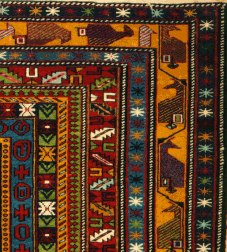
From a technical view the finish of the carpet's sides, the
selvage, the techniques used in knotting the fringe, the style
of the warp and weft interactions, all prove beyond doubt the
origin. By comparison, of the ornamental motifs of the investigated
carpet with well-known samples of Azerbaijan "OLD SHIRVAN"s, the following findings.
From "Catalogue of Carpets of Azerbaijan, published USSR,
1952", the following literal coincidences were discovered:
These coincidences, taken together with the symbols, techniques
and coloration noted earlier, confirm the fact of belonging this
carpet to the tradition "OLD SHIRVAN".
- Ornaments with wine-glass and leaves completely coincides
with samples on tables #
33, 36,45
- Ornaments with stars completely coincides with samples on
table # 42;
- Toothed ornaments near the red-white drawing of interlaced
cord completely coincides with samples on table # 26;
- Ornament, represented stylised flower bud, which is situated
in the comer of lower sector, and defined as a stamp of master
from Marsali tribe,
completely coincides with samples on table # 38.
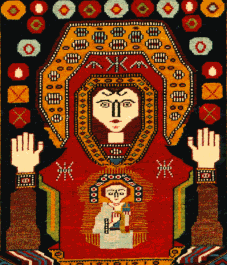 The centre of
carpet includes two parts. The upper part is a picture of an icon,
around it we can see its own frame made of red ornaments in blue
field, in what it is easily noticed drawings of the Cross. The
colourful gamut is very harmonious: red, beige, and light-olive
wonderfully distinguish and underline bright, rhythm-organised
ornaments, give us sense of holiday formed festive frame for central
figures:
The centre of
carpet includes two parts. The upper part is a picture of an icon,
around it we can see its own frame made of red ornaments in blue
field, in what it is easily noticed drawings of the Cross. The
colourful gamut is very harmonious: red, beige, and light-olive
wonderfully distinguish and underline bright, rhythm-organised
ornaments, give us sense of holiday formed festive frame for central
figures:
The Iconography can be traced to one of the most sacred icons
in Russia - The Yaroslavskaya Oranta from the 13th century,
kept in State Tretyakovskaya
gallery, Russia. Our supposition was supported by senior research
worker of Restoration's department Parphyonova T.G.
(Kremlin
museums) and ex-head
former of Research department, candidate of historical science
Lebedeva I.V. (Andrey Rublyov Museum).
These icons are a united pose of Our Lady with up-lifted arms
in prayer, drawing Christ Emanuel
in medallion form on Our Lady's breast, with star-shaped decorations
on shoulders figure, and "zarukavniki"
(special sleeves), embroidered by pearls.
But on Yaroslavskaya
Oranta Our Lady was drawn in whole height, while the icon on carpet is a half-length portrait. Probably,
true original icon for weaver, who made this carpet, was latest icon,
history of which we should know later. (Editor's note: Please
see the report on Icons in the printing, which depicts a number
of icons of similar nature).
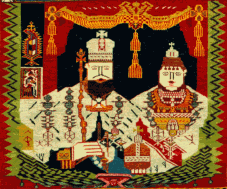 The
lower part of the central field is a portrait of Alexander III
and Tsarina Marie Feodorovna. They are drawn in full tsarist regalia: crowns, ermine mantle, medals,
and jewels. The Tsar holds "derzhava" (orb) and
"skipetr"
(sceptre), the symbols of royal power. The figures are situated
under bright-red canopy with golden-yellow fringe and tassels. From below figures are framed by
stylised moiré
ribbon.
The
lower part of the central field is a portrait of Alexander III
and Tsarina Marie Feodorovna. They are drawn in full tsarist regalia: crowns, ermine mantle, medals,
and jewels. The Tsar holds "derzhava" (orb) and
"skipetr"
(sceptre), the symbols of royal power. The figures are situated
under bright-red canopy with golden-yellow fringe and tassels. From below figures are framed by
stylised moiré
ribbon.
Portraits were not usual for Caucasus carpets.
The majority of eastern carpets belong to Muslim culture. Muslim
dogmatism forbids drawings of alive beings. But at the same time,
it is known, that this interdiction was not always kept. For sample
we can see Persian "luxurious" carpets with many figures
of people, close to famous Persian miniatures in style. Caucasus
tradition did not totally refuse from drawing portraits, but figures
of people were always strictly stylised.
In that case we can see
unique memorial, which was made for the special celebrations,
we can suppose, that working at portraits was difficult for the
weaver, but he made it with bright success. This portrait is stylised,
ornamental and plain, but nevertheless it is a portrait.
Apparently, the carpet with the portrait of
Alexander III
was made to special order and it used a special pattern, which
was made by another artist. The pattern maker had access to a
painting of the coronation and the ikon. These patterns, called
"cartoon" in the textile trade, were painstakingly transferred
on ruling paper, where every square signed a knot. In this carpet
another cartoon would have been made of the Ikon being modelled,
then a complete cartoon of the entire carpet made which included
all details of the two panel cartoons.
HISTORICAL INFORMATION
SYMBOLISM OF
THE CARPET AS A PART OF EASTERN CULTURAL TRADITION.
The Motherland of carpets is The East. And
namely there people lend increasing symbolical importance to carpets.
Carpets form the ancient eastern dwelling, are used as a bed and
a seat, a saddle consists of carpets, five times a day carpets
are used in time of prayer. All of these functions keep in many
and many special knots of wool or silk threads. It can give birth
of a lot of associations, such as: Ancient knot written language,
and sea-knots of Phoenician seafarers, and knots, named "Tsitsyt"
on Jewish "talits". Concentrated energy, kept in a
carpet, in its ornament, colour combinations and rhythm
of composition
promise good fortune and happiness for its owner.
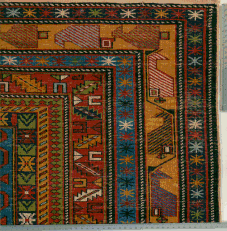 The
method of creation of a carpet is simple yet incredibly labour-consuming
work. First the cartoons, which here would involve trips to St.
Petersburg or Moscow from the Caucasus to make the patterns, the
carding of the wool, gathering of the natural dyes, the cleaning
and dying process, then finally the actual construction.
The
method of creation of a carpet is simple yet incredibly labour-consuming
work. First the cartoons, which here would involve trips to St.
Petersburg or Moscow from the Caucasus to make the patterns, the
carding of the wool, gathering of the natural dyes, the cleaning
and dying process, then finally the actual construction.
The number of knots, that skilful weaver can
make during a day, is fluctuating between six and ten thousands.
Before knotting the weaver must string the numerous weft threads
(vertical threads from top to bottom) as the framework upon which
the carpet is constructed. After knotting, the carpet must be
trimmed and beaten. This carpet containing approximately 575,000
knots with a tight weave and many colour changes the weaving,
framework, and trimming time would be about 150 days. A reasonable
estimate of the total time involved in all processes for this
carpet is about one year or more.
Carpets were presented to ancient sovereigns
as special, magnificent and valuable gifts. A carpet was kept
in a family and was given from one generation to next. From this
point of view, the carpet with coronation portrait of Alexander
III and Tsarina Maria Feodorovna, which was presented Tsar Alexander
III from Shirvan,
one of Caucasus regions in Russian empire, is the last memorial,
confirming all claims of ancient traditions.
HISTORY OF CARPET WITH
PORTRAIT OF TSAR'S COUPLE
THE INTRIGUE
Alexander III was
a true Russian autocrat, who made the real attempts for unification
of Russian lands, of strengthening of empire's borders. For a
long time the reign of Alexander III was described by historians as a time of reaction.
But now this point of view has began to change. Although, the
best Russian historians always marked the positive features of
the reign of Alexander III: 'Foreign policy of emperor Alexander
III was notable for definition and steadiness…Constancy of
Russian Sovereign in maintenance of the common peace and sincerity
of his peaceful disposition gave him the denomination 'peacemaker'.
The date of accession was 1881, but as was
common, only later would come the actual ceremonies attended by
royalty and officials world-wide. Coronation celebrations in 1883
were made with great splendour and enterprise. There were such
magnificent arrangements as unveiling of Christ The Saviour Cathedral,
for the first time in Moscow electricity illumination was organised,
the best Russian artists were invited for the decoration of this
celebrations. For example, Victor Vasnetsov, the famous Russian
artist, made menu for restaurants in honour of this celebration.
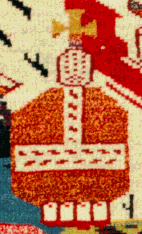 The
central field of this carpet was divided on two parts. The lower
part of the central field is a portrait of Alexander III and Tsarina
Maria Feodorovna at the moment of the coronation, this fact is
confirmed by the detail eye-witness accounts, which were published
in 1883: '...descending down the Red Porch, His Majesty Emperor
with Her Majesty Empress were pleased to stand under the canopy
and slowly proceeded to the Cathedral...', the other eye-witness remembered: '…and,
standing under a canopy, and stalked with crowns and purples,
and His Majesty Emperor with "derzhava" (see photo)
and "skipetr" in his hands, to The Archangel
Cathedral .
The
central field of this carpet was divided on two parts. The lower
part of the central field is a portrait of Alexander III and Tsarina
Maria Feodorovna at the moment of the coronation, this fact is
confirmed by the detail eye-witness accounts, which were published
in 1883: '...descending down the Red Porch, His Majesty Emperor
with Her Majesty Empress were pleased to stand under the canopy
and slowly proceeded to the Cathedral...', the other eye-witness remembered: '…and,
standing under a canopy, and stalked with crowns and purples,
and His Majesty Emperor with "derzhava" (see photo)
and "skipetr" in his hands, to The Archangel
Cathedral .
Alexander III ascended the throne after his
father Alexander II, who had been killed by a bomb explosion.
He was very cautious of attempts on his life. For celebrations,
few representatives of nobility, ambassadors of foreign Powers
and superior complement of Officers corps were admitted straight
to the Kremlin. The celebrations for people were organised
on Moscow's streets and they could watch the solemn procession
only a great distance away, from some elevated place.
According to recollections of the wonderful
Russian artist Vasifij Surikov, the figure of Alexander III stood out by mighty height and stateliness and
he was seen from afar, making imposing and solemn effect. At once after
Coronation celebrations special albums, calendars and cards with
pictures of scenes
of solemnity and its description were published. On one of these pictures the Tsar and Tsarina were
printed standing under a canopy with royal regalia in hands..
Such gift could be presented for special case.
It is well-known fact, that Alexander III was passionate collector
of works of art, especially he loved the works of obscure folk
masters (icons, carpets, unique dishes), which were delivered
to him as a present through his courtiers in attendance. K.P. Pobedonostsev, ober-procurator of the Synod,
who exerted great influence on the Tsar (for example, S. Lubosh
called him 'the inspirer of new reign) often promoted such kind
of replenishment of the Tsar's collection, and traditionally after
the gift was presented, there had to be an audience, at which
a grantor could set forth his request.
How had to act cunning
eastern magnate?
…who wanted Tsar Alexander
III to pay special attention to his gift?
The ceremony of presenting carpets to sovereign
is the century-old tradition of the East. But how can you present
this gift, showing, that it is very valuable and it is absolutely
unusual, and at the same time you must flatter to Tsar's taste?
Alexander III's passion to collect of icons was well-known. For
instance. throughout the entire journey of Tsar's cortege during
Tsar's travel to Volga's area in 1881 'big delegations from all strata
of society gathered for salutation Their Majesties and for presentation
to them icons, bread-and-salt, and local works of art".
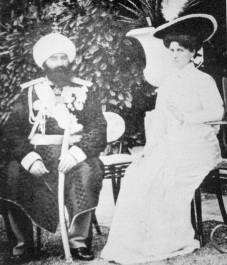 Knowing
about Tsar's passion to icons, an unknown grantor orders not only
traditional, and, of course, valuable hirvan, carpet, but expresses the wish to see the picture
of icon in the central field of carpet. How our research shows,
the choice of icon was not casual and has the deep symbolic meaning.
Customer meant definite best wishes to Tsar's family, ordered
to picture namely this icon. The photograph depicts Empress Maria
Feodorovna during the 1888 trip with Abdul- Akhad-Khan, Emir Of
Bukhara.
Knowing
about Tsar's passion to icons, an unknown grantor orders not only
traditional, and, of course, valuable hirvan, carpet, but expresses the wish to see the picture
of icon in the central field of carpet. How our research shows,
the choice of icon was not casual and has the deep symbolic meaning.
Customer meant definite best wishes to Tsar's family, ordered
to picture namely this icon. The photograph depicts Empress Maria
Feodorovna during the 1888 trip with Abdul- Akhad-Khan, Emir Of
Bukhara.
Tradition of Romanov
Textile Portraits
 During
analysis of the problem of creation of the carpet namely with
portrait of Tsar's pair, it is necessary to remember, that gifts
of works of art with the portraits of the members of Tsar 's
family were traditional
for Russian court. On the left is pictured a Tsar Peter 1st (The Great)
tapestry portrait. (81 x 64 cm collection of Moscow Kremlin Museums)
During
analysis of the problem of creation of the carpet namely with
portrait of Tsar's pair, it is necessary to remember, that gifts
of works of art with the portraits of the members of Tsar 's
family were traditional
for Russian court. On the left is pictured a Tsar Peter 1st (The Great)
tapestry portrait. (81 x 64 cm collection of Moscow Kremlin Museums)
It is known, for example, that ladies from
Yaroslavl (during the travel of Alexander III to the Volga's area)
presented to Her Majesty Empress special address, in which they
asked to receive from them
"…a picture, which is made by
professor Makarov in Saint-Petersburg, the plot
of this picture is God, who blesses the children, the portraits
of whom are the portraits of Sons and Daughter of Their Majesties"
Alexander III kept works of art presented to him with care and
put these gifts, as a rule, either in summer residence in Alexandrijskij Peterhofskij cottage, or in Gatchinskij
palace.
"...during the alteration of Alexandrijskij
cottage
the luxury carpets were brought first", and…"..,floors
and walls covered with rich eastern carpets" .
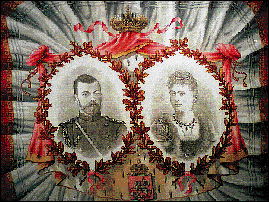
After Alexander III, the tradition continued
with Nicholas II, as exampled by this portrait. However this example
is a mass produced item for sale to the people, not an item designed
for the Royal couple. Nonetheless it remains an important historical
representation, and such items are a fine addition to any Russian
art collection.
HISTORICAL MEANING
OF THIS MEMORIAL
SIGNIFICANCE RETURNING
THIS CARPET TO RUSSIA
At our time, when collectors, who have possibilities to collect
rare works of art, are appearing in Russia again, it is especially
important, this memorial of decorative and applied art , which has significance as a historical memorial too, will be
returned to Russia. We must remark that the period of reign of
Alexander III is not presented enough in our museums.
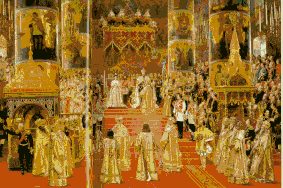 Coronation of Alexander
III
1888 painting
Coronation of Alexander
III
1888 painting
The exhibition "Coronation of Russian
emperors", in the Schusev Museum of architecture not long
ago, showed that the least quantity of documents were kept concerning
the Alexander III reign. By the words of M.G. Rogosina, the senior
research worker of photo-archives in Schusev Museum of architecture,
this period is represented very scantily. Senior research worker
of photo-archives there, Saygina L.V. added that the mistakes
of soviet historians must be corrected by the modern scientists:
The time of Emperor Alexander III was a
very interesting period in Russian art. Alexander III collected
a good collection of works of art. Especially valuable part of
this collection is a part of folk works of art. Tsar's assistants
were well-educated experts and had a subtle taste. There are many interesting pieces of folk
art (carpet, porcelain and the like) in this collection. I am
sure all of these pieces have a great art and material value.
(Signed)
Elena Kobkova
 The details of
this carpet show that it belongs to the tradition of "OLD
SHIRVAN". This includes the two and one-quarter square meter
(2 ¼ m5 ) size,
dimension of which are 128 cm wide by 176 cm long; the high quality
wool with which it was made; the quality
and chemical composition of the dyes. Additionally the character
of ornament , such as the border design and particularly the symbols
above the Tsar's right shoulder as depicted in the photograph
to the left.
The details of
this carpet show that it belongs to the tradition of "OLD
SHIRVAN". This includes the two and one-quarter square meter
(2 ¼ m5 ) size,
dimension of which are 128 cm wide by 176 cm long; the high quality
wool with which it was made; the quality
and chemical composition of the dyes. Additionally the character
of ornament , such as the border design and particularly the symbols
above the Tsar's right shoulder as depicted in the photograph
to the left. 
 The
lower part of the central field is a portrait of Alexander
The
lower part of the central field is a portrait of Alexander  The
method of creation of a carpet is simple yet incredibly
The
method of creation of a carpet is simple yet incredibly  The
central field of this carpet was divided on two parts. The lower
part of the central field is a portrait of Alexander III and Tsarina
Maria Feodorovna at the moment of the coronation, this fact is
confirmed by the detail eye-witness accounts, which were published
in 1883: '...descending down the Red Porch, His Majesty Emperor
with Her Majesty Empress were pleased to stand under the canopy
and slowly proceeded to the Cathedral...
The
central field of this carpet was divided on two parts. The lower
part of the central field is a portrait of Alexander III and Tsarina
Maria Feodorovna at the moment of the coronation, this fact is
confirmed by the detail eye-witness accounts, which were published
in 1883: '...descending down the Red Porch, His Majesty Emperor
with Her Majesty Empress were pleased to stand under the canopy
and slowly proceeded to the Cathedral... Knowing
about Tsar's passion to icons, an unknown grantor orders not only
traditional, and, of course, valuable
Knowing
about Tsar's passion to icons, an unknown grantor orders not only
traditional, and, of course, valuable  During
analysis of the problem of creation of the carpet namely with
portrait of Tsar's pair, it is necessary to remember, that gifts
of works of art with the portraits of the members of Tsar
During
analysis of the problem of creation of the carpet namely with
portrait of Tsar's pair, it is necessary to remember, that gifts
of works of art with the portraits of the members of Tsar 
